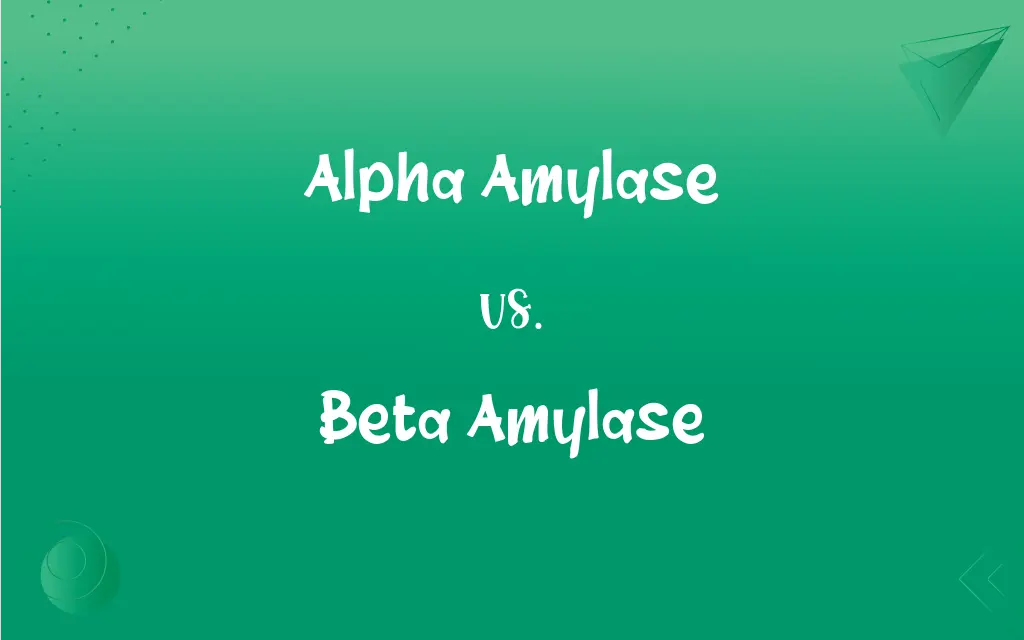Alpha Amylase vs. Beta Amylase: What's the Difference?
Edited by Janet White || By Harlon Moss || Updated on October 24, 2023
Alpha amylase breaks down starch at random points, producing varied-sized sugars. Beta amylase cleaves starch at specific ends, yielding maltose.

Key Differences
Alpha amylase and beta amylase are both enzymes that break down starches, but their mechanisms differ. Alpha amylase, found in human saliva and pancreas, randomly cleaves the starch molecules, resulting in various-sized sugar chains. In contrast, beta amylase, predominantly found in plant seeds and malted grains, acts at the non-reducing end of the starch molecule to consistently produce maltose.
In brewing, both alpha amylase and beta amylase play vital roles. Alpha amylase works optimally at higher temperatures, converting large starch molecules into smaller dextrins, which gives body to the beer. On the other hand, beta amylase functions best at lower temperatures, producing maltose, a fermentable sugar that yeast can utilize.
The activity of alpha amylase is often measured in clinical settings, as its elevated levels can indicate certain conditions like pancreatitis. Meanwhile, beta amylase has its significance in the food industry, where it's used to produce maltose syrup, a sweetening agent.
From an evolutionary standpoint, alpha amylase and beta amylase have different origins and are coded by separate genes. Alpha amylase is prevalent in mammals and some microorganisms, aiding in the initial digestion of dietary starches. Conversely, plants primarily produce beta amylase, which facilitates seed germination by providing a readily available energy source in the form of maltose.
Comparison Chart
Action Site
Randomly breaks down starch
Breaks starch at specific ends
ADVERTISEMENT
Product
Varied-sized sugars
Maltose
Optimal Temperature
Higher temperatures
Lower temperatures
Primary Source
Human saliva and pancreas
Plant seeds and malted grains
Industrial Use
Diagnostic for certain medical conditions
Production of maltose syrup
Alpha Amylase and Beta Amylase Definitions
Alpha Amylase
Found mainly in human saliva and the pancreas.
Doctors might measure alpha amylase levels in a blood test.
ADVERTISEMENT
Beta Amylase
Functions best at cooler temperatures.
For maximum maltose production in brewing, beta amylase needs cooler temperatures.
Alpha Amylase
An enzyme that randomly cleaves starch molecules.
I learned that our saliva contains alpha amylase to begin starch digestion.
Beta Amylase
Primarily found in plant seeds and malted grains.
During seed germination, beta amylase breaks down stored starches.
Alpha Amylase
Works optimally at higher temperatures.
In brewing, alpha amylase operates best at elevated temperatures.
Beta Amylase
Key in the food industry for maltose syrup creation.
Many candies use maltose syrup, thanks to beta amylase's action.
Alpha Amylase
Responsible for breaking down large starches into smaller dextrins.
Alpha amylase provides body to beer by producing dextrins.
Beta Amylase
Predominant in plants and aids in seed germination.
Seeds utilize beta amylase to access energy for sprouting.
Alpha Amylase
Used as a diagnostic marker for certain medical conditions.
Elevated alpha amylase can be a sign of pancreatitis.
Beta Amylase
An enzyme that specifically produces maltose from starch.
Beta amylase is essential in malt production for brewing.
FAQs
What is alpha amylase?
Alpha amylase is an enzyme that breaks down starches randomly, producing various-sized sugar chains.
What is beta amylase?
Beta amylase is an enzyme that acts at the non-reducing end of starch molecules to produce maltose.
How does alpha amylase differ in action from beta amylase?
While alpha amylase breaks starches down randomly, beta amylase acts specifically at the ends.
Where is alpha amylase found?
It's mainly found in human saliva and the pancreas.
Where is beta amylase predominantly found?
It's primarily found in plant seeds and malted grains.
Can we measure alpha amylase activity?
Yes, it's often measured in clinical settings to diagnose certain conditions.
Why is beta amylase crucial in candy production?
It's used to produce maltose syrup, a sweetening agent in many candies.
What happens if alpha amylase levels are elevated in the blood?
Elevated levels can indicate conditions like pancreatitis.
Is alpha amylase only found in humans?
No, it's also prevalent in some microorganisms.
Why is beta amylase significant in malt production?
It consistently produces maltose, a fermentable sugar used in brewing.
Which enzyme is more specific in its starch-breaking action?
Beta amylase is more specific, producing only maltose.
Why is alpha amylase present in saliva?
It initiates the digestion of dietary starches in the mouth.
How do plants benefit from beta amylase?
It aids in seed germination by providing an energy source.
Can both enzymes coexist in the same environment?
Yes, especially in brewing, where both play vital roles.
Is beta amylase exclusive to plants?
Predominantly, but it can also be found in some microorganisms.
Why is alpha amylase important in brewing?
It breaks large starch molecules into smaller dextrins, giving body to beer.
Which enzyme works best at higher temperatures?
Alpha amylase operates optimally at higher temperatures.
Which enzyme is crucial for maltose syrup production?
Beta amylase is key for creating maltose syrup in the food industry.
What role does beta amylase play during seed germination?
It provides a readily available energy source in the form of maltose.
Do both enzymes have the same origin?
No, they have different evolutionary origins and are coded by separate genes.
About Author
Written by
Harlon MossHarlon is a seasoned quality moderator and accomplished content writer for Difference Wiki. An alumnus of the prestigious University of California, he earned his degree in Computer Science. Leveraging his academic background, Harlon brings a meticulous and informed perspective to his work, ensuring content accuracy and excellence.
Edited by
Janet WhiteJanet White has been an esteemed writer and blogger for Difference Wiki. Holding a Master's degree in Science and Medical Journalism from the prestigious Boston University, she has consistently demonstrated her expertise and passion for her field. When she's not immersed in her work, Janet relishes her time exercising, delving into a good book, and cherishing moments with friends and family.
































































